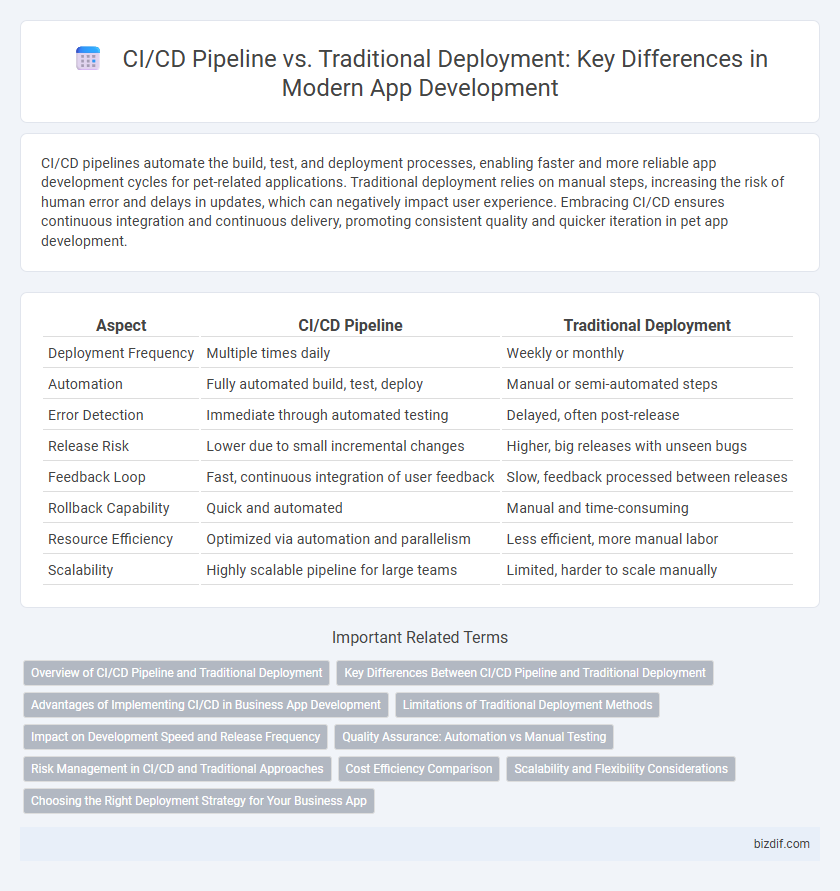CI/CD pipelines automate the build, test, and deployment processes, enabling faster and more reliable app development cycles for pet-related applications. Traditional deployment relies on manual steps, increasing the risk of human error and delays in updates, which can negatively impact user experience. Embracing CI/CD ensures continuous integration and continuous delivery, promoting consistent quality and quicker iteration in pet app development.
Table of Comparison
| Aspect | CI/CD Pipeline | Traditional Deployment |
|---|---|---|
| Deployment Frequency | Multiple times daily | Weekly or monthly |
| Automation | Fully automated build, test, deploy | Manual or semi-automated steps |
| Error Detection | Immediate through automated testing | Delayed, often post-release |
| Release Risk | Lower due to small incremental changes | Higher, big releases with unseen bugs |
| Feedback Loop | Fast, continuous integration of user feedback | Slow, feedback processed between releases |
| Rollback Capability | Quick and automated | Manual and time-consuming |
| Resource Efficiency | Optimized via automation and parallelism | Less efficient, more manual labor |
| Scalability | Highly scalable pipeline for large teams | Limited, harder to scale manually |
Overview of CI/CD Pipeline and Traditional Deployment
The CI/CD pipeline automates code integration, testing, and deployment, enabling faster and more reliable app development cycles. Traditional deployment relies on manual processes for building, testing, and releasing software, often leading to longer release times and higher error rates. Continuous integration and continuous delivery streamline updates, improve code quality, and enhance collaboration among development teams.
Key Differences Between CI/CD Pipeline and Traditional Deployment
CI/CD pipeline automates the integration, testing, and deployment processes, enabling rapid and frequent software releases, whereas traditional deployment relies on manual integration and infrequent updates. Continuous integration in CI/CD ensures code changes are automatically tested and merged, reducing errors and integration conflicts common in traditional methods. The continuous delivery aspect of CI/CD pipelines promotes faster feedback loops and faster time-to-market, contrasting with the slower, more error-prone traditional deployment cycles.
Advantages of Implementing CI/CD in Business App Development
Implementing a CI/CD pipeline in business app development significantly accelerates software delivery by automating build, test, and deployment processes, reducing manual errors and downtime. Continuous integration ensures code quality through frequent automated testing, enabling faster detection and resolution of bugs. This streamlined approach enhances collaboration among development teams, promotes faster feature releases, and improves overall application reliability compared to traditional deployment methods.
Limitations of Traditional Deployment Methods
Traditional deployment methods face significant limitations such as extended release cycles and higher risk of human error, leading to inconsistent application performance. Manual processes often result in delayed bug fixes and feature updates, reducing overall development agility and increasing downtime. These constraints hinder the ability to quickly adapt to market demands compared to automated CI/CD pipelines.
Impact on Development Speed and Release Frequency
CI/CD pipelines automate testing and integration, significantly accelerating development speed by enabling rapid code validation and deployment. This continuous process allows for multiple releases per day, increasing release frequency and reducing time-to-market. Traditional deployment methods, relying on manual processes and infrequent releases, slow down development cycles and delay product updates.
Quality Assurance: Automation vs Manual Testing
CI/CD pipelines enhance quality assurance by integrating automated testing frameworks that enable continuous verification of code with immediate feedback on defects, significantly reducing human error and accelerating release cycles. Traditional deployment relies heavily on manual testing, which often leads to longer testing phases, inconsistent coverage, and higher risk of undetected bugs in production. Automated testing within CI/CD ensures consistent test execution, scalability, and rapid identification of issues, boosting software reliability compared to the slower, labor-intensive manual QA processes.
Risk Management in CI/CD and Traditional Approaches
CI/CD pipeline enhances risk management by enabling continuous integration, automated testing, and rapid deployment, which significantly reduces the likelihood of defects reaching production. Traditional deployment methods often rely on manual processes and infrequent releases, increasing the risk of undetected bugs and longer rollback times. CI/CD practices facilitate immediate feedback and iterative improvements, minimizing downtime and improving overall software stability.
Cost Efficiency Comparison
CI/CD pipelines reduce deployment costs by automating testing and integration, minimizing manual errors and downtime compared to traditional deployment methods. Traditional deployment often incurs higher expenses due to prolonged deployment cycles, manual interventions, and increased risk of rollback and bug fixes. Implementing CI/CD enables faster release cycles and continuous delivery, ultimately lowering operational costs and improving resource allocation.
Scalability and Flexibility Considerations
CI/CD pipeline enables seamless scalability by automating code integration, testing, and deployment, allowing rapid adaptation to changing user demands and infrastructure needs. Traditional deployment often faces limitations in flexibility due to manual processes, increasing the risk of errors and slower response times during scaling. Embracing CI/CD enhances continuous delivery while providing dynamic scalability and greater operational flexibility in app development environments.
Choosing the Right Deployment Strategy for Your Business App
Efficient app development hinges on selecting the optimal deployment strategy; CI/CD pipelines automate continuous integration, testing, and delivery, ensuring faster release cycles and reduced human error compared to traditional deployment. Businesses aiming for rapid iteration and frequent updates benefit from CI/CD's scalability and automation, while established systems with lower update frequency may prefer traditional deployment for stability. Aligning deployment methods with application complexity, team expertise, and update requirements is critical for maximizing performance and minimizing downtime.
CI/CD Pipeline vs Traditional Deployment Infographic

 bizdif.com
bizdif.com